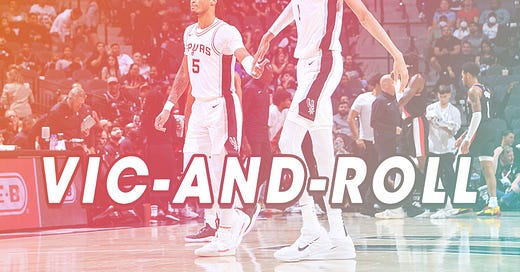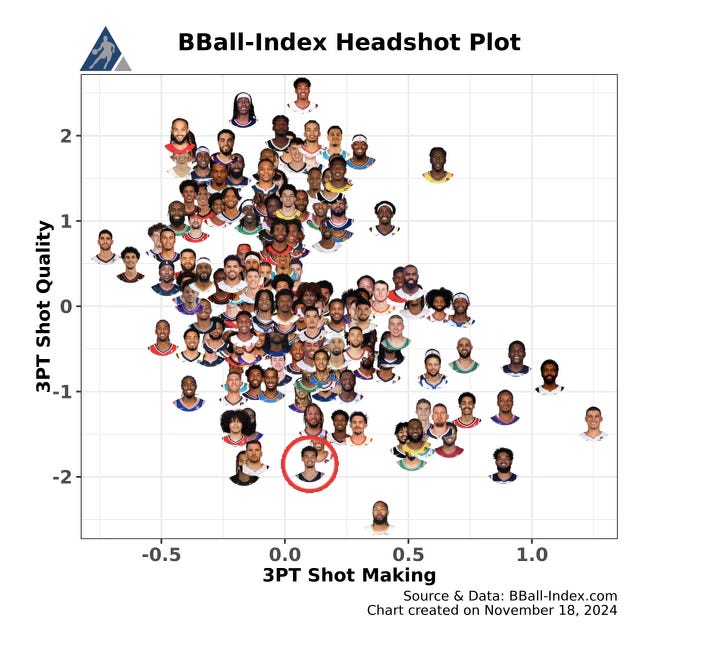Vic-and-Roll Mailbag: Wembanyama Shot Diet, Castle Conundrum, and Pet Plays
The retooled Spurs are finding their footing in the early goings of the season.
Welcome to our first mailbag of the season! Our readers submitted their best Spurs questions on Substack, and have some detailed answers to those thoughtful queries!
We are so thankful of your support for the publication! Chime off in the comments and let us know what other topics have been on your mind early into the schedule!
If you don’t see your question, don’t fret! We have them archived for a future mailbag podcast, so feel free to reach out to us on Facebook, Threads, Twitter, and Reddit!
1.) Do you think Stephon Castle will continue starting once Jeremy Sochan returns? -
Jeremy Sochan was on the brink of a breakout season, averaging a career-high 15.4 points per game on 51.2% shooting from the field before a left thumb fracture sent him to the sidelines indefinitely earlier this month. While that untimely setback put an immediate stopper in the coming out party for the 21-year-old, it also opened the door for Stephon Castle to assume a more substantial role in the nightly rotation.
Since his emergency promotion to the starting lineup, Castle has averaged 13.7 points, 2.6 rebounds, and 4.0 assists on .453/.387/.762 shooting splits, an encouraging response from a rookie who labored on the offensive end out of the gates. A seven-game sample size is too small to make a conclusive declaration about how the coaching staff should approach things once Sochan returns, but it is a discussion worth having.
For proponents of San Antonio making Castle a full-time starter, there is perhaps no better evidence of his positive impact than the +35.7 Net Rating the team owns when he shares the hardwood with Victor Wembanyama, Chris Paul, Harrison Barnes, and Julian Champagnie. For more context, that number ranks second in the NBA among all five-man lineups that have logged at least 50 minutes together this season.
Between his recent surge in three-point efficiency, versatility as a guard screener, and processing speed as both an on-ball and connective playmaker, Castle has periodically looked like the third-best player on the court for the Spurs for short spans this season. He has also provided glimpses into his immense defensive potential, giving household names like Kyrie Irving, De’Aaron Fox, and Anthony Edwards headaches.
Answering this question is challenging because the Spurs still have to decide whether to send Champagnie or Barnes back to the bench once Devin Vassell is no longer on a minutes restriction. With Sochan on the shelf for at least another month, Castle could have several outings to prove his production is no fluke, not to mention the likelihood San Antonio eases the former back into the rotation once he is cleared to play.
The possibilities are endless, especially if Brian Wright gets busy at the trade deadline and deals CP3 for salary filler and additional draft capital. In that case, Spurs fans may experience a best-of-both-worlds scenario where Sochan and Castle coexist as starters for the second half of the season. Either way, San Antonio has invested too much into Jeremy to relegate him to sixth-man duties amid another rebuilding campaign.
2.) Have you noticed any sets emerging as go-to’s for the Spurs this season? -
Horns - Pinch - Flex is a play Gregg Popovich has routinely turned to since winning the Wembanyama sweepstakes, and this is a set we have looked over several times on The Vic-and-Roll. The video below is an example of how these actions work to create easy offense for the Spurs.
3.) Why has Zach Collins played fewer minutes if his three-point percentage has been better? -
Despite rattling home 40% of his three-pointers through the first 14 games of the year, Zach Collins has registered the fewest minutes of his career. At first glance, you might think that is somewhat surprising, especially since his inability to space the floor was ostensibly one of the central reasons he failed to receive more playing time during his first three seasons in San Antonio. However, shooting is only the tip of the iceberg.
Collins has been uncharacteristically efficient from deep, but opponents are too smart to overreact to his early returns. Because his defenders refuse to close out with a sense of urgency and sag off of him to stunt on drives or tag team pick-and-roll ballhandlers, his presence still shrinks the floor. And with the coaching staff no longer interested in trotting him out next to Victor Wembanyama, he only gets the second-unit scraps.
Couple that shortcoming with mediocre rim finishing (64.3%), nominal rim protection, and limited scheme versatility as a drop coverage big man, and you have a recipe for a more traditional center. That archetype has continued to lose traction across the NBA with each passing season, and though his high-post playmaking is a plus, the ship has sailed on Collins being anything more than trade fodder or salary filler for this club.
4.) Why is Wembanyama spending less time inside the paint than last spring? Is it a spacing issue? -
This is an excellent question with an answer that has less to do with spacing than you probably imagine. Believe it or not, the Spurs have been much better in that area than a season ago, placing ninth in three-point volume (39.1) and 16th in percentage (35.2%) through their first 14 outings. Those numbers could wane, but that doesn’t change the reasoning behind why Wembanyama is spending less time inside the paint.
What is the explanation, then? There are two main factors. One: The Spurs have 100% bought into the notion that Wembanyama is a perimeter player on the offensive end, a sentiment Coach Popovich shared with the media during a postgame press conference on Halloween. Two: Defenses are adjusting to him, and they are sending double teams when he touches the ball near the post to make him uncomfortable on the interior.
As paradoxical as this may seem, Wembanyama has benefitted from operating heavily on the perimeter. Since most opponents still toss their center on the Parisian Phenom, he can make them pay for biting on pump fakes to create driving lanes off the dribble. And when they fail to recover back to him on pick-and-pops or sink too deep into the paint in drop coverage, he also has the range to punish them from deep.
Victor lacks the strength to displace fellow seven-footers with his back to the basket, so forcing him to work on the blocks makes little sense unless he has a size mismatch against a much smaller defender. With the Spurs letting him explore the studio space and discover the limits of his comfort zone, his efficiency as a vertical spacer and roll man has shined as the quality of his shots inside the restricted area has spiked.
5.) Can Malaki Branham sustain his hot shooting from three? And is there room for him in the rotation? -
As much as we love to give youngsters the benefit of the doubt here, trusting Malaki Branham has become increasingly difficult. The former first-rounder had a promising rookie season for the Spurs, showcasing a polished in-between game that could evolve into a genuine weapon if he could only rediscover the spot-up shooting that made him such a fascinating three-level scoring prospect coming out of Ohio State.
His second go-round in the 2-1-0 saw the unfortunate arrival of a dreaded sophomore slump, where he regressed as a midrange shooter and struggled to find the soft touch that made his floaters such an effective counterpunch. Even with slim improvements to his three-point percentage as a stationary marksman, his lackadaisical defense and deterioration elsewhere made him a noticeable net negative for San Antonio.
We are now in year three, where Branham is draining a career-high 46.7% of his three-balls on a respectable volume of 6.2 attempts per 36 minutes. So why has the coaching staff hesitated to hand the 21-year-old a longer leash and extended run? Well, you can look no further than his horrendous on-off metrics. The Spurs are 20.1 points per 100 possessions better when he sits, which puts him in the bottom third percentile.
The advanced statistics match what the eye test has told us over the last three seasons, and San Antonio has no incentive to mix him into the rotation when a crammed depth chart leaves them with limited minutes to stretch between Stephon Castle, Chris Paul, Devin Vassell, Julian Champagnie, Tre Jones, and Blake Wesley. A minor ankle sprain didn’t help his cause, but it likely only delayed his slide in the pecking order.
6.) Are there any metrics other than three-point percentage that you’re watching as Wemby develops his shooting from distance? -
Three-Point Shot Quality and Three-Point Shot Making are metrics from BBall Index that go hand in hand when we want to take a more nuanced look at Wembanyama and his shooting from distance. The former combines factors like openness, self-creation, movement, and location to measure shot quality. The latter calculates shooting talent based on the expected three-point percentage given that shot quality.
As you can see from this graph, Wembanyama has a three-point shot quality that only ranks above Brandon Ingram, Karl Anthony Towns, and Jordan Clarkson. However, he places in the middle of the pack in shot-making. So, essentially, this tells us Victor has been better than expected despite having an undeniably difficult shot diet. At least for me, this bodes well for his long-term outlook, especially given the roster context.
Besides Devin Vassell, who has been out for all but four games, and occasionally Chris Paul, who is well past his prime, no one on the Spurs possesses the shooting gravity or advantage creation to put Wembanyama in a favorable position on a regular basis. Just look at the threes the young superstar has made over his last four games. I’m alright to reserve judgment until the supporting cast has been molded to maximize his skillset.





